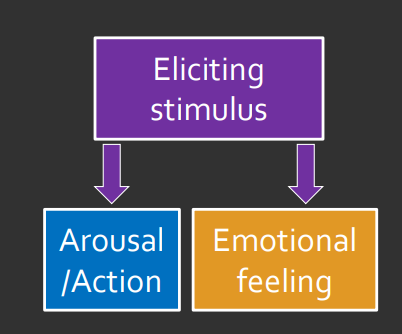Neuro Theories of Emotion
1/12
There's no tags or description
Looks like no tags are added yet.
Name | Mastery | Learn | Test | Matching | Spaced |
|---|
No study sessions yet.
13 Terms
3 Components of emotion
physiological response, subjective experience, and overt behavior
James-Lange Theory
Emotion stems from bodily feedback
James-Lange Chart
What theory does this chart belong to?

Cannon-Bard Theory
The physiological and conscious components of emotion are actually independent and happen simultaneously
Cannon-Bard Chart
What theory does this chart belong to?

Schachter-Singer Theory
Emotion comes from physiological arousal plus your cognitive appraisal. The CNS then labels as conscious feeling.
Schachter-Singer Chart
What theory does this chart belong to?

Sander’s Models of Emotion
Explains emotion through five perspectives. Expression, action tendency, bodily reaction, feeling, and cognition.
Expression model emphasizes
Basic emotions shown through facial expressions and body language. (eg. Ekman’s work)
Action tendency model emphasizes
Emotions as drivers of approach or avoidance behaviors. (eg. Carver and Scheier)
Bodily reaction model emphasizes
Emotion as physiological changes in the body. Linked to theories like James/Damasio vs Cannon.
Feeling model emphasizes
Emotions as conscious experiences involving valence (positive/negative emotion) and arousal (intensity).
Cognition model emphasizes
The influence of cognition and appraisal on emotions, connected to the emotion-cognition debate.